HND Computing and System: Data Analysis and Design Report
VerifiedAdded on 2024/05/16
|81
|6932
|57
Report
AI Summary
This report provides a detailed analysis of data analysis and design concepts within the context of an HND Computing and System course at Wentworth House. It critically compares different data models and schemas, discusses the benefits and limitations of database technologies, and outlines an approach to database design. The report also covers relational DBMS design, building relational database systems, and tools for enhancing the user interface. Furthermore, it explores query tools, the implementation of query languages in RDBMS, and the estimation of extracting meaningful data. The document includes a critical review and testing of a relational database system, documentation to support implementation and testing, a user document for the developed system, and addresses verification, validation, and control mechanisms. This comprehensive analysis aims to provide a thorough understanding of data analysis and database design principles.
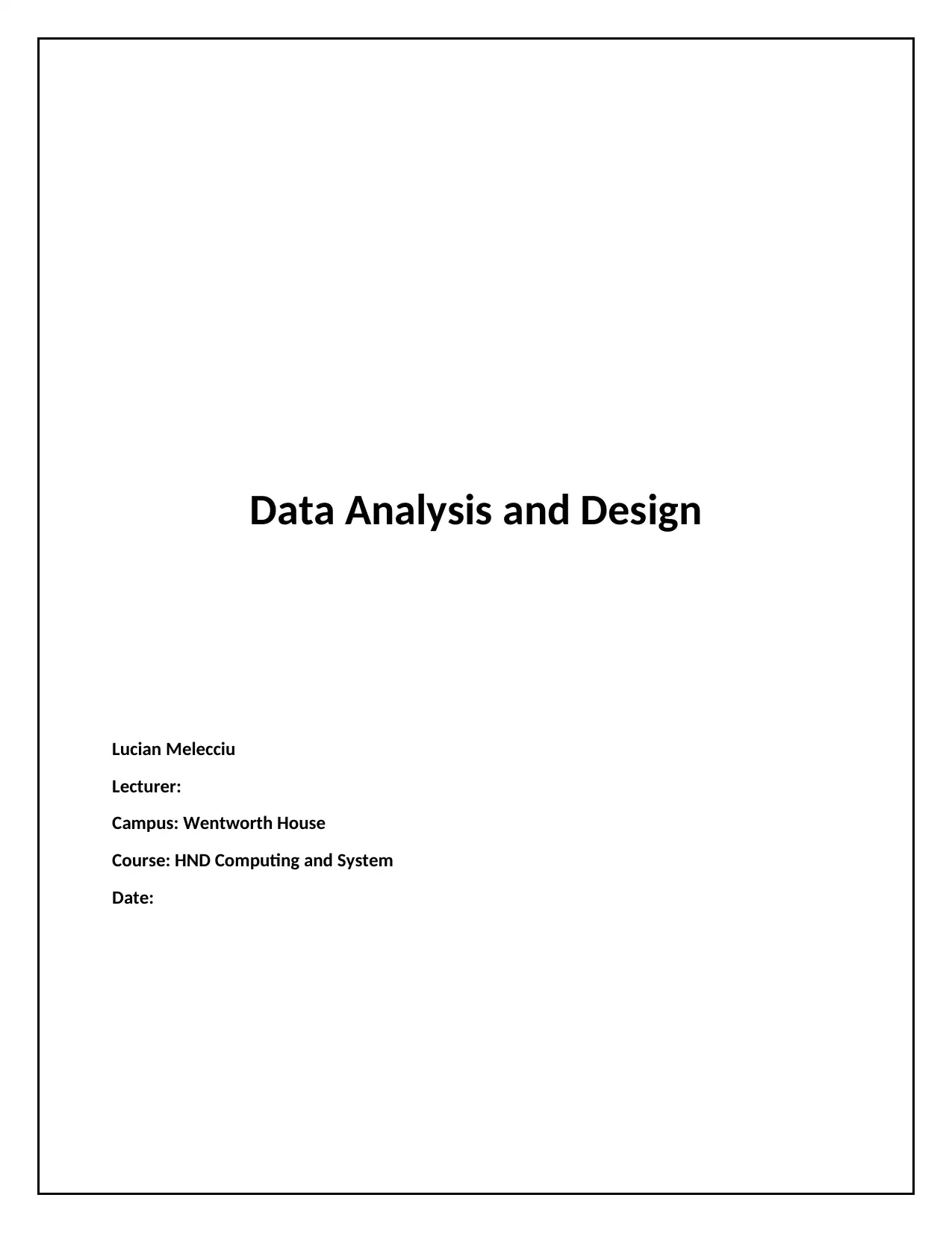
Data Analysis and Design
Lucian Melecciu
Lecturer:
Campus: Wentworth House
Course: HND Computing and System
Date:
Lucian Melecciu
Lecturer:
Campus: Wentworth House
Course: HND Computing and System
Date:
Paraphrase This Document
Need a fresh take? Get an instant paraphrase of this document with our AI Paraphraser
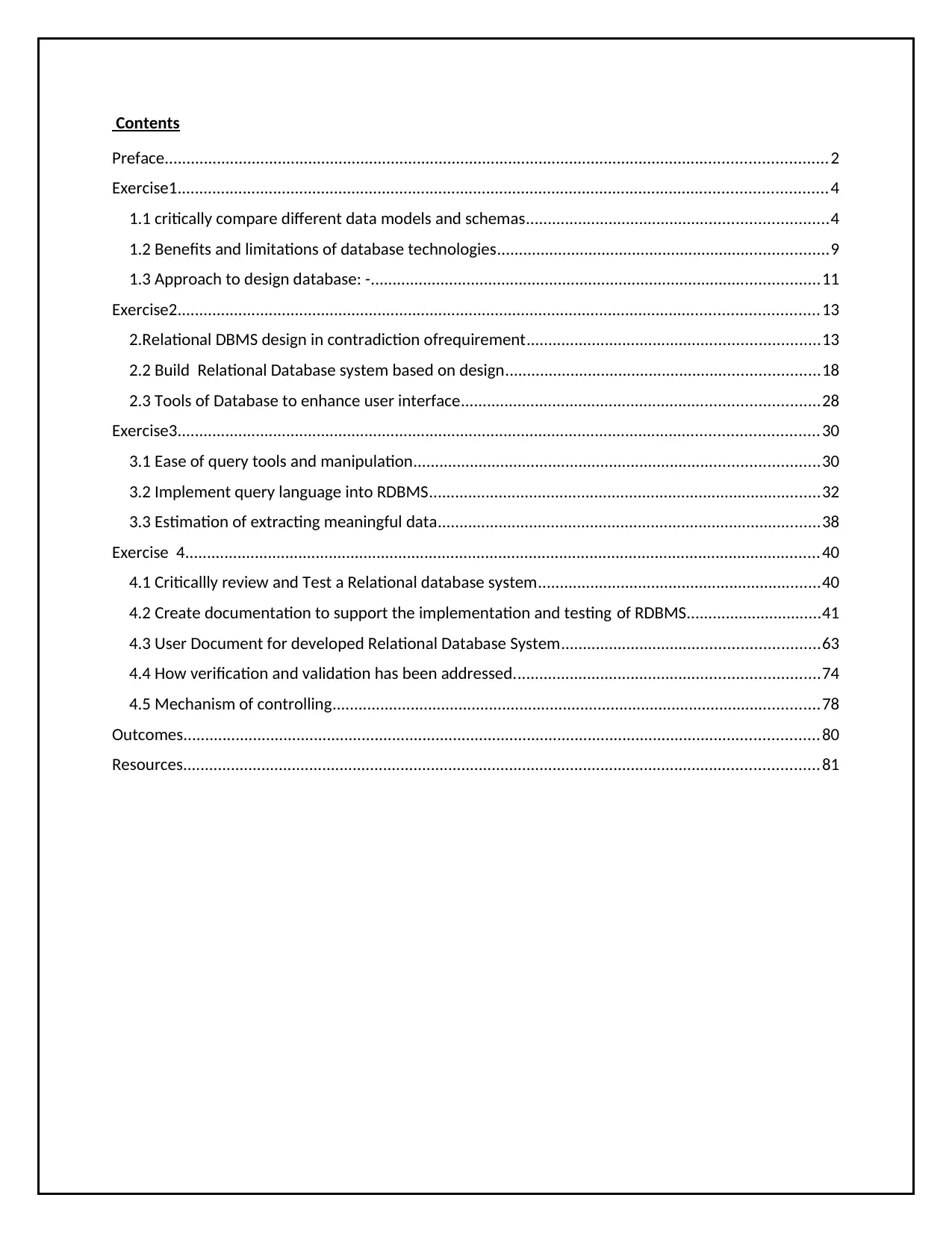
Contents
Preface........................................................................................................................................................2
Exercise1.....................................................................................................................................................4
1.1 critically compare different data models and schemas.....................................................................4
1.2 Benefits and limitations of database technologies............................................................................9
1.3 Approach to design database: -.......................................................................................................11
Exercise2...................................................................................................................................................13
2.Relational DBMS design in contradiction ofrequirement...................................................................13
2.2 Build Relational Database system based on design........................................................................18
2.3 Tools of Database to enhance user interface..................................................................................28
Exercise3...................................................................................................................................................30
3.1 Ease of query tools and manipulation.............................................................................................30
3.2 Implement query language into RDBMS..........................................................................................32
3.3 Estimation of extracting meaningful data........................................................................................38
Exercise 4..................................................................................................................................................40
4.1 Criticallly review and Test a Relational database system.................................................................40
4.2 Create documentation to support the implementation and testing of RDBMS...............................41
4.3 User Document for developed Relational Database System...........................................................63
4.4 How verification and validation has been addressed......................................................................74
4.5 Mechanism of controlling................................................................................................................78
Outcomes..................................................................................................................................................80
Resources..................................................................................................................................................81
Preface........................................................................................................................................................2
Exercise1.....................................................................................................................................................4
1.1 critically compare different data models and schemas.....................................................................4
1.2 Benefits and limitations of database technologies............................................................................9
1.3 Approach to design database: -.......................................................................................................11
Exercise2...................................................................................................................................................13
2.Relational DBMS design in contradiction ofrequirement...................................................................13
2.2 Build Relational Database system based on design........................................................................18
2.3 Tools of Database to enhance user interface..................................................................................28
Exercise3...................................................................................................................................................30
3.1 Ease of query tools and manipulation.............................................................................................30
3.2 Implement query language into RDBMS..........................................................................................32
3.3 Estimation of extracting meaningful data........................................................................................38
Exercise 4..................................................................................................................................................40
4.1 Criticallly review and Test a Relational database system.................................................................40
4.2 Create documentation to support the implementation and testing of RDBMS...............................41
4.3 User Document for developed Relational Database System...........................................................63
4.4 How verification and validation has been addressed......................................................................74
4.5 Mechanism of controlling................................................................................................................78
Outcomes..................................................................................................................................................80
Resources..................................................................................................................................................81
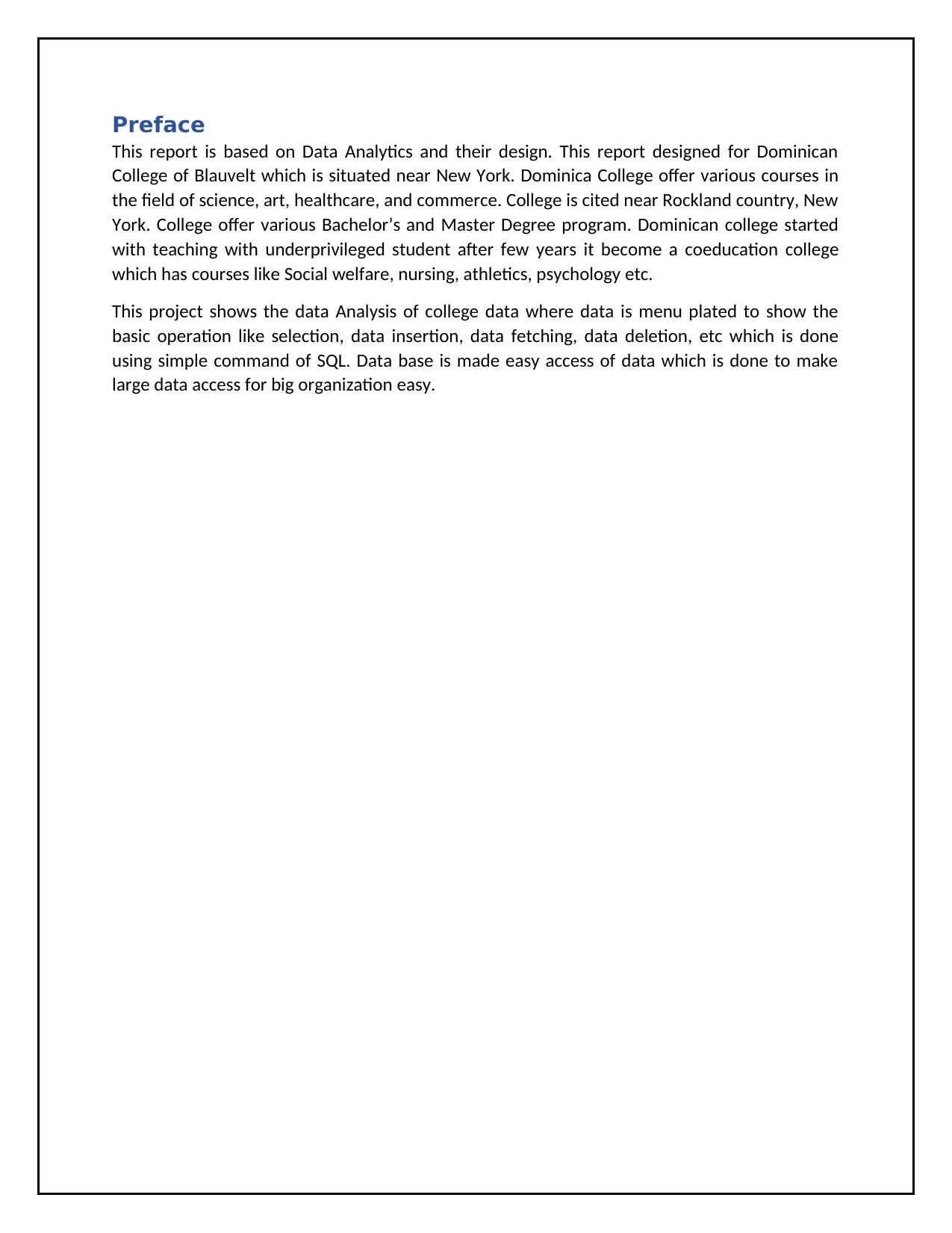
Preface
This report is based on Data Analytics and their design. This report designed for Dominican
College of Blauvelt which is situated near New York. Dominica College offer various courses in
the field of science, art, healthcare, and commerce. College is cited near Rockland country, New
York. College offer various Bachelor’s and Master Degree program. Dominican college started
with teaching with underprivileged student after few years it become a coeducation college
which has courses like Social welfare, nursing, athletics, psychology etc.
This project shows the data Analysis of college data where data is menu plated to show the
basic operation like selection, data insertion, data fetching, data deletion, etc which is done
using simple command of SQL. Data base is made easy access of data which is done to make
large data access for big organization easy.
This report is based on Data Analytics and their design. This report designed for Dominican
College of Blauvelt which is situated near New York. Dominica College offer various courses in
the field of science, art, healthcare, and commerce. College is cited near Rockland country, New
York. College offer various Bachelor’s and Master Degree program. Dominican college started
with teaching with underprivileged student after few years it become a coeducation college
which has courses like Social welfare, nursing, athletics, psychology etc.
This project shows the data Analysis of college data where data is menu plated to show the
basic operation like selection, data insertion, data fetching, data deletion, etc which is done
using simple command of SQL. Data base is made easy access of data which is done to make
large data access for big organization easy.
⊘ This is a preview!⊘
Do you want full access?
Subscribe today to unlock all pages.

Trusted by 1+ million students worldwide
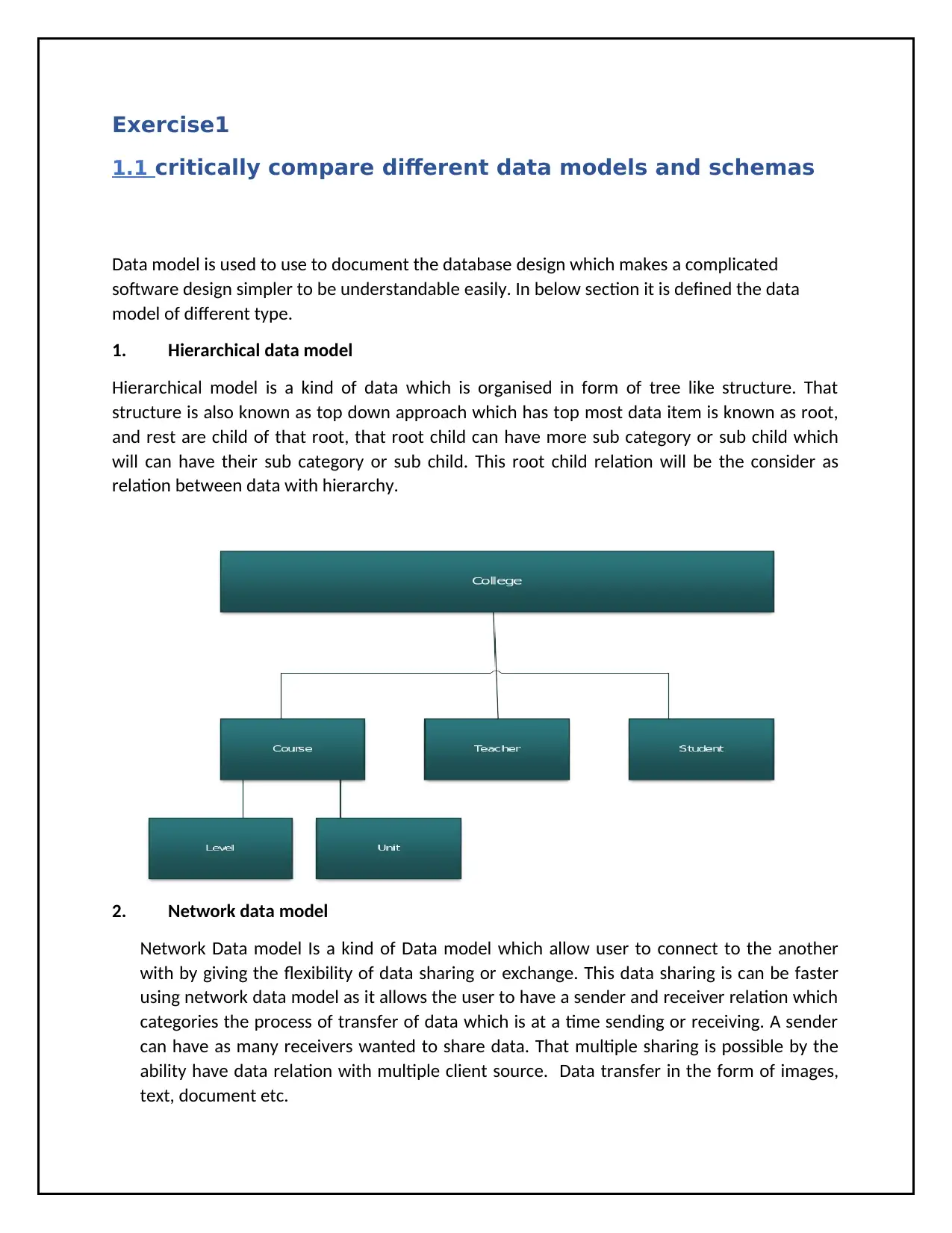
Exercise1
1.1 critically compare different data models and schemas
Data model is used to use to document the database design which makes a complicated
software design simpler to be understandable easily. In below section it is defined the data
model of different type.
1. Hierarchical data model
Hierarchical model is a kind of data which is organised in form of tree like structure. That
structure is also known as top down approach which has top most data item is known as root,
and rest are child of that root, that root child can have more sub category or sub child which
will can have their sub category or sub child. This root child relation will be the consider as
relation between data with hierarchy.
2. Network data model
Network Data model Is a kind of Data model which allow user to connect to the another
with by giving the flexibility of data sharing or exchange. This data sharing is can be faster
using network data model as it allows the user to have a sender and receiver relation which
categories the process of transfer of data which is at a time sending or receiving. A sender
can have as many receivers wanted to share data. That multiple sharing is possible by the
ability have data relation with multiple client source. Data transfer in the form of images,
text, document etc.
1.1 critically compare different data models and schemas
Data model is used to use to document the database design which makes a complicated
software design simpler to be understandable easily. In below section it is defined the data
model of different type.
1. Hierarchical data model
Hierarchical model is a kind of data which is organised in form of tree like structure. That
structure is also known as top down approach which has top most data item is known as root,
and rest are child of that root, that root child can have more sub category or sub child which
will can have their sub category or sub child. This root child relation will be the consider as
relation between data with hierarchy.
2. Network data model
Network Data model Is a kind of Data model which allow user to connect to the another
with by giving the flexibility of data sharing or exchange. This data sharing is can be faster
using network data model as it allows the user to have a sender and receiver relation which
categories the process of transfer of data which is at a time sending or receiving. A sender
can have as many receivers wanted to share data. That multiple sharing is possible by the
ability have data relation with multiple client source. Data transfer in the form of images,
text, document etc.
Paraphrase This Document
Need a fresh take? Get an instant paraphrase of this document with our AI Paraphraser
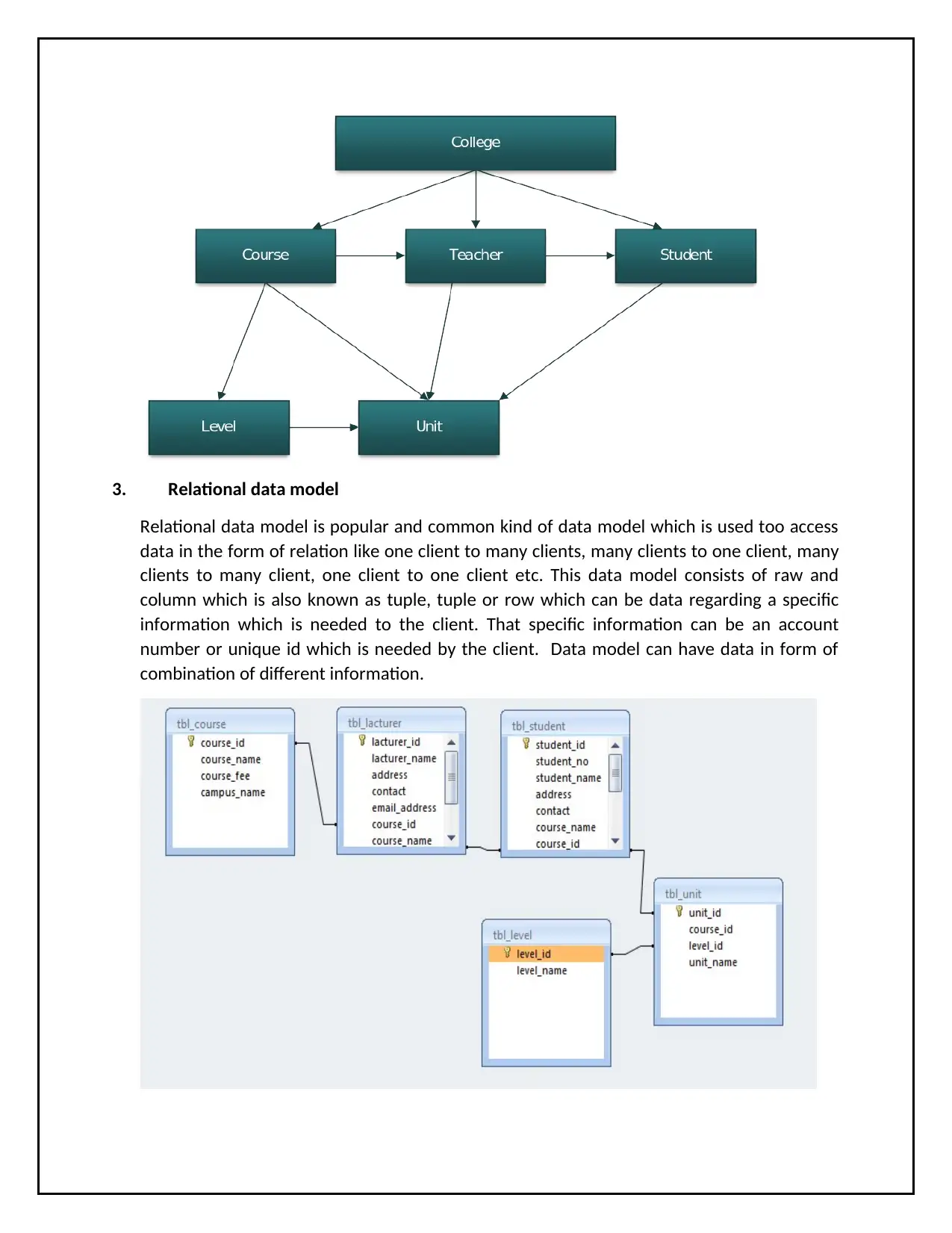
3. Relational data model
Relational data model is popular and common kind of data model which is used too access
data in the form of relation like one client to many clients, many clients to one client, many
clients to many client, one client to one client etc. This data model consists of raw and
column which is also known as tuple, tuple or row which can be data regarding a specific
information which is needed to the client. That specific information can be an account
number or unique id which is needed by the client. Data model can have data in form of
combination of different information.
Relational data model is popular and common kind of data model which is used too access
data in the form of relation like one client to many clients, many clients to one client, many
clients to many client, one client to one client etc. This data model consists of raw and
column which is also known as tuple, tuple or row which can be data regarding a specific
information which is needed to the client. That specific information can be an account
number or unique id which is needed by the client. Data model can have data in form of
combination of different information.
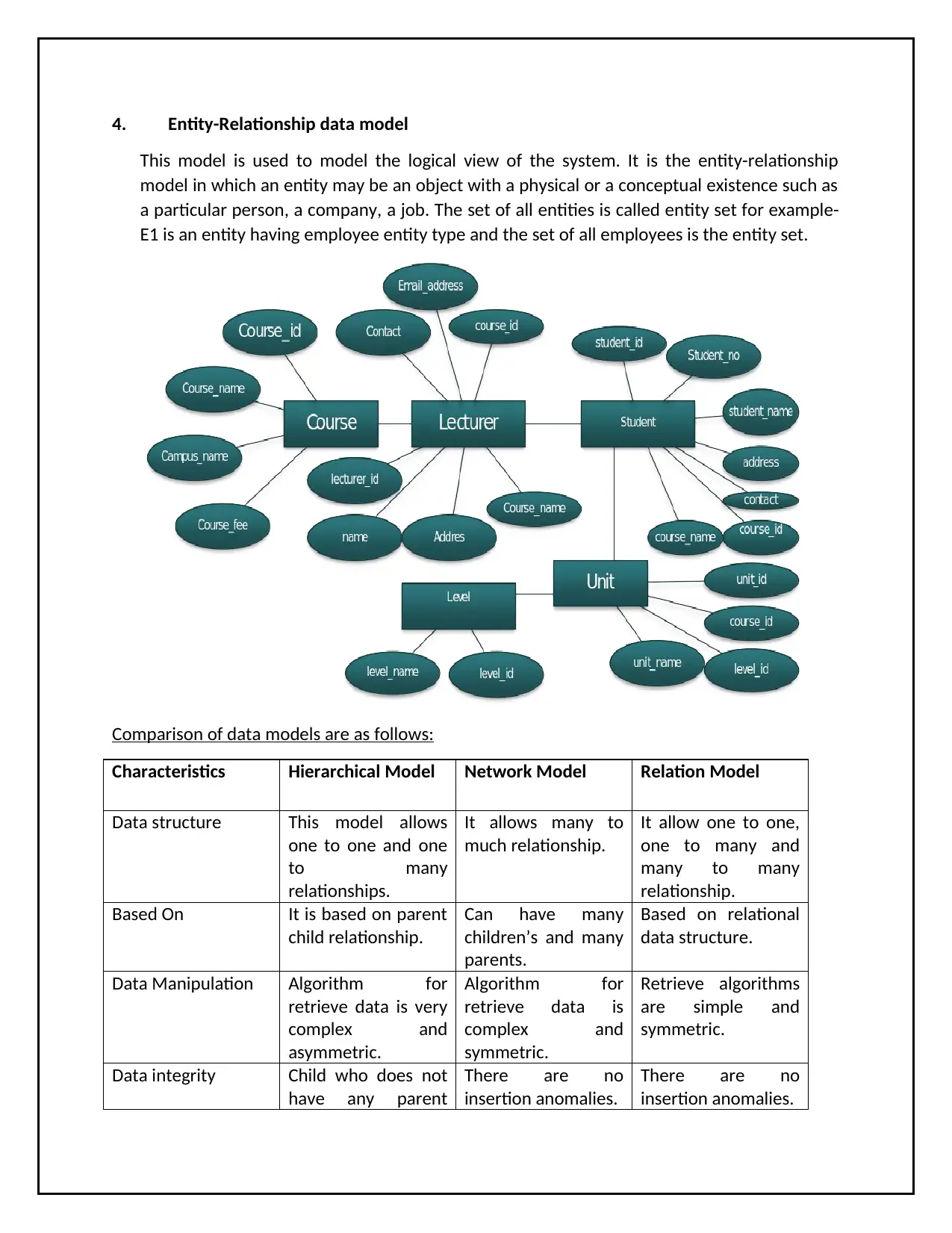
4. Entity-Relationship data model
This model is used to model the logical view of the system. It is the entity-relationship
model in which an entity may be an object with a physical or a conceptual existence such as
a particular person, a company, a job. The set of all entities is called entity set for example-
E1 is an entity having employee entity type and the set of all employees is the entity set.
Comparison of data models are as follows:
Characteristics Hierarchical Model Network Model Relation Model
Data structure This model allows
one to one and one
to many
relationships.
It allows many to
much relationship.
It allow one to one,
one to many and
many to many
relationship.
Based On It is based on parent
child relationship.
Can have many
children’s and many
parents.
Based on relational
data structure.
Data Manipulation Algorithm for
retrieve data is very
complex and
asymmetric.
Algorithm for
retrieve data is
complex and
symmetric.
Retrieve algorithms
are simple and
symmetric.
Data integrity Child who does not
have any parent
There are no
insertion anomalies.
There are no
insertion anomalies.
This model is used to model the logical view of the system. It is the entity-relationship
model in which an entity may be an object with a physical or a conceptual existence such as
a particular person, a company, a job. The set of all entities is called entity set for example-
E1 is an entity having employee entity type and the set of all employees is the entity set.
Comparison of data models are as follows:
Characteristics Hierarchical Model Network Model Relation Model
Data structure This model allows
one to one and one
to many
relationships.
It allows many to
much relationship.
It allow one to one,
one to many and
many to many
relationship.
Based On It is based on parent
child relationship.
Can have many
children’s and many
parents.
Based on relational
data structure.
Data Manipulation Algorithm for
retrieve data is very
complex and
asymmetric.
Algorithm for
retrieve data is
complex and
symmetric.
Retrieve algorithms
are simple and
symmetric.
Data integrity Child who does not
have any parent
There are no
insertion anomalies.
There are no
insertion anomalies.
⊘ This is a preview!⊘
Do you want full access?
Subscribe today to unlock all pages.

Trusted by 1+ million students worldwide
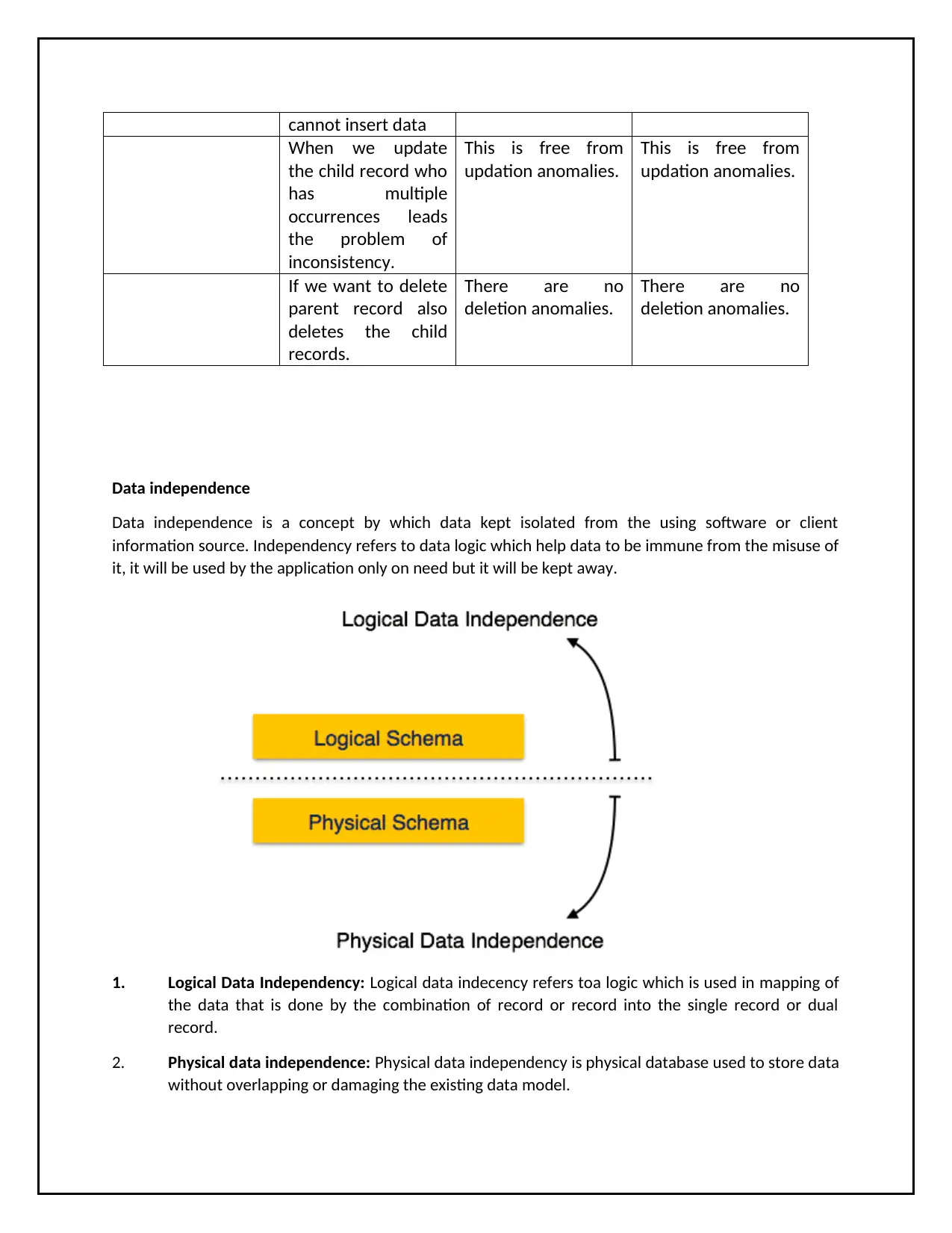
cannot insert data
When we update
the child record who
has multiple
occurrences leads
the problem of
inconsistency.
This is free from
updation anomalies.
This is free from
updation anomalies.
If we want to delete
parent record also
deletes the child
records.
There are no
deletion anomalies.
There are no
deletion anomalies.
Data independence
Data independence is a concept by which data kept isolated from the using software or client
information source. Independency refers to data logic which help data to be immune from the misuse of
it, it will be used by the application only on need but it will be kept away.
1. Logical Data Independency: Logical data indecency refers toa logic which is used in mapping of
the data that is done by the combination of record or record into the single record or dual
record.
2. Physical data independence: Physical data independency is physical database used to store data
without overlapping or damaging the existing data model.
When we update
the child record who
has multiple
occurrences leads
the problem of
inconsistency.
This is free from
updation anomalies.
This is free from
updation anomalies.
If we want to delete
parent record also
deletes the child
records.
There are no
deletion anomalies.
There are no
deletion anomalies.
Data independence
Data independence is a concept by which data kept isolated from the using software or client
information source. Independency refers to data logic which help data to be immune from the misuse of
it, it will be used by the application only on need but it will be kept away.
1. Logical Data Independency: Logical data indecency refers toa logic which is used in mapping of
the data that is done by the combination of record or record into the single record or dual
record.
2. Physical data independence: Physical data independency is physical database used to store data
without overlapping or damaging the existing data model.
Paraphrase This Document
Need a fresh take? Get an instant paraphrase of this document with our AI Paraphraser
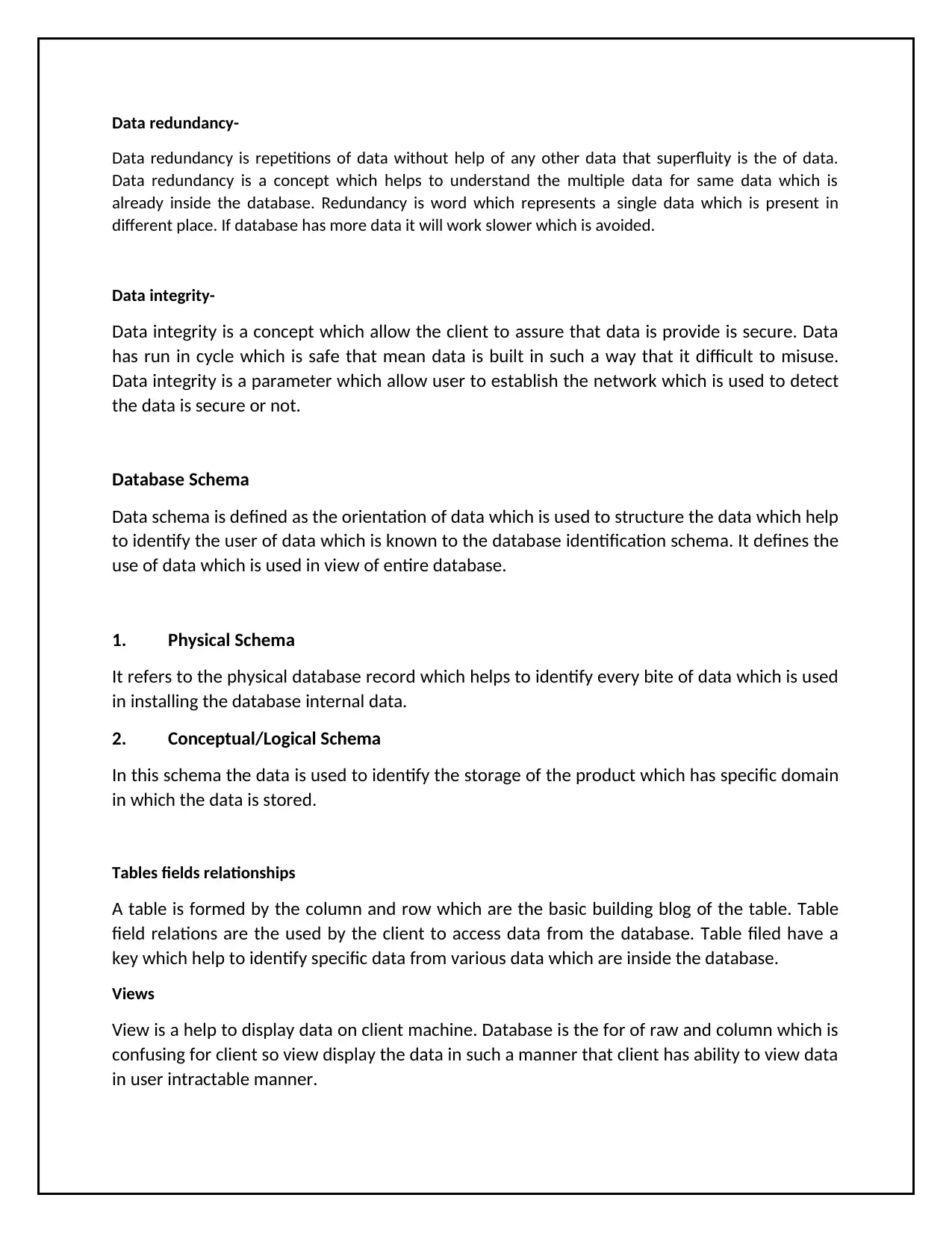
Data redundancy-
Data redundancy is repetitions of data without help of any other data that superfluity is the of data.
Data redundancy is a concept which helps to understand the multiple data for same data which is
already inside the database. Redundancy is word which represents a single data which is present in
different place. If database has more data it will work slower which is avoided.
Data integrity-
Data integrity is a concept which allow the client to assure that data is provide is secure. Data
has run in cycle which is safe that mean data is built in such a way that it difficult to misuse.
Data integrity is a parameter which allow user to establish the network which is used to detect
the data is secure or not.
Database Schema
Data schema is defined as the orientation of data which is used to structure the data which help
to identify the user of data which is known to the database identification schema. It defines the
use of data which is used in view of entire database.
1. Physical Schema
It refers to the physical database record which helps to identify every bite of data which is used
in installing the database internal data.
2. Conceptual/Logical Schema
In this schema the data is used to identify the storage of the product which has specific domain
in which the data is stored.
Tables fields relationships
A table is formed by the column and row which are the basic building blog of the table. Table
field relations are the used by the client to access data from the database. Table filed have a
key which help to identify specific data from various data which are inside the database.
Views
View is a help to display data on client machine. Database is the for of raw and column which is
confusing for client so view display the data in such a manner that client has ability to view data
in user intractable manner.
Data redundancy is repetitions of data without help of any other data that superfluity is the of data.
Data redundancy is a concept which helps to understand the multiple data for same data which is
already inside the database. Redundancy is word which represents a single data which is present in
different place. If database has more data it will work slower which is avoided.
Data integrity-
Data integrity is a concept which allow the client to assure that data is provide is secure. Data
has run in cycle which is safe that mean data is built in such a way that it difficult to misuse.
Data integrity is a parameter which allow user to establish the network which is used to detect
the data is secure or not.
Database Schema
Data schema is defined as the orientation of data which is used to structure the data which help
to identify the user of data which is known to the database identification schema. It defines the
use of data which is used in view of entire database.
1. Physical Schema
It refers to the physical database record which helps to identify every bite of data which is used
in installing the database internal data.
2. Conceptual/Logical Schema
In this schema the data is used to identify the storage of the product which has specific domain
in which the data is stored.
Tables fields relationships
A table is formed by the column and row which are the basic building blog of the table. Table
field relations are the used by the client to access data from the database. Table filed have a
key which help to identify specific data from various data which are inside the database.
Views
View is a help to display data on client machine. Database is the for of raw and column which is
confusing for client so view display the data in such a manner that client has ability to view data
in user intractable manner.
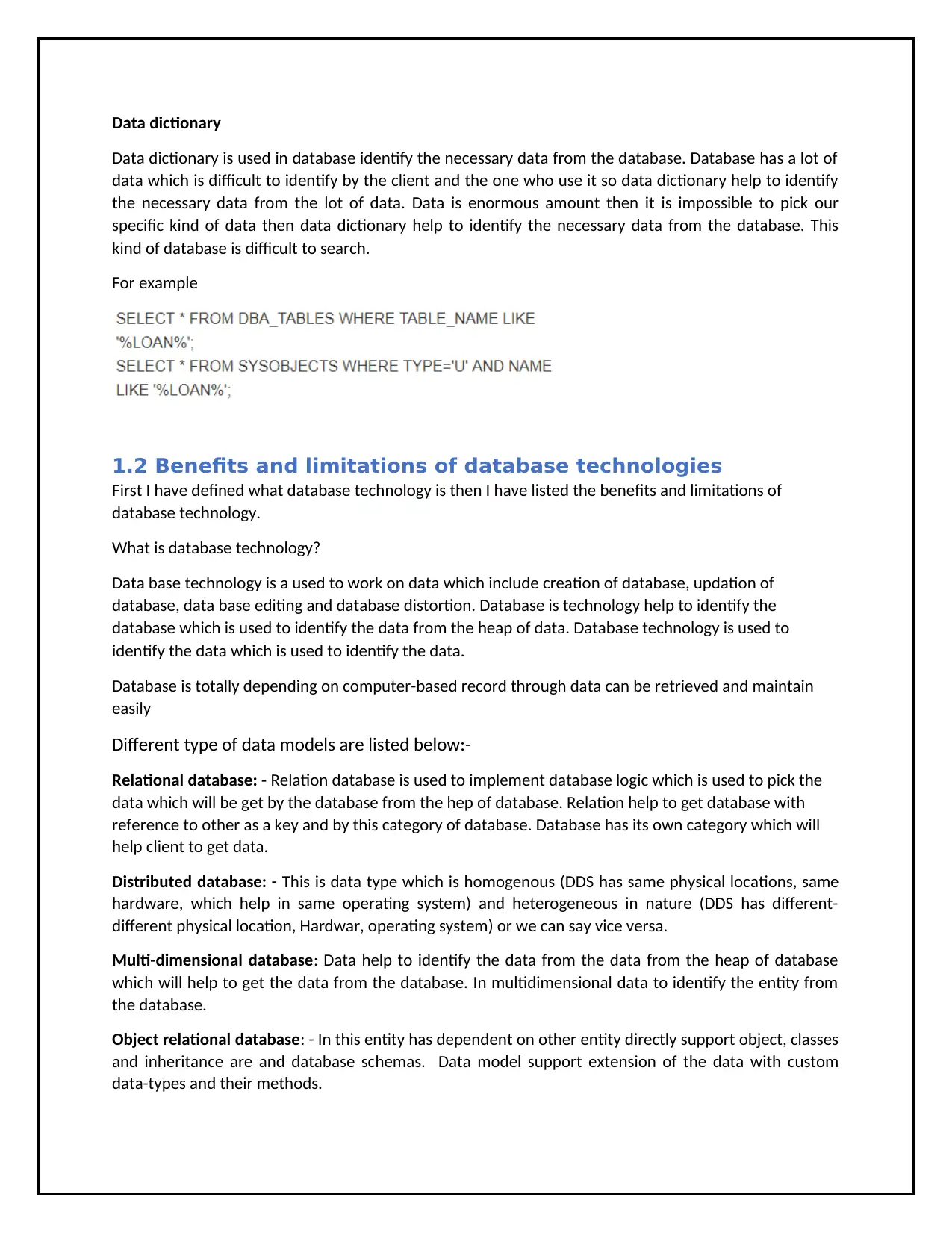
Data dictionary
Data dictionary is used in database identify the necessary data from the database. Database has a lot of
data which is difficult to identify by the client and the one who use it so data dictionary help to identify
the necessary data from the lot of data. Data is enormous amount then it is impossible to pick our
specific kind of data then data dictionary help to identify the necessary data from the database. This
kind of database is difficult to search.
For example
1.2 Benefits and limitations of database technologies
First I have defined what database technology is then I have listed the benefits and limitations of
database technology.
What is database technology?
Data base technology is a used to work on data which include creation of database, updation of
database, data base editing and database distortion. Database is technology help to identify the
database which is used to identify the data from the heap of data. Database technology is used to
identify the data which is used to identify the data.
Database is totally depending on computer-based record through data can be retrieved and maintain
easily
Different type of data models are listed below:-
Relational database: - Relation database is used to implement database logic which is used to pick the
data which will be get by the database from the hep of database. Relation help to get database with
reference to other as a key and by this category of database. Database has its own category which will
help client to get data.
Distributed database: - This is data type which is homogenous (DDS has same physical locations, same
hardware, which help in same operating system) and heterogeneous in nature (DDS has different-
different physical location, Hardwar, operating system) or we can say vice versa.
Multi-dimensional database: Data help to identify the data from the data from the heap of database
which will help to get the data from the database. In multidimensional data to identify the entity from
the database.
Object relational database: - In this entity has dependent on other entity directly support object, classes
and inheritance are and database schemas. Data model support extension of the data with custom
data-types and their methods.
Data dictionary is used in database identify the necessary data from the database. Database has a lot of
data which is difficult to identify by the client and the one who use it so data dictionary help to identify
the necessary data from the lot of data. Data is enormous amount then it is impossible to pick our
specific kind of data then data dictionary help to identify the necessary data from the database. This
kind of database is difficult to search.
For example
1.2 Benefits and limitations of database technologies
First I have defined what database technology is then I have listed the benefits and limitations of
database technology.
What is database technology?
Data base technology is a used to work on data which include creation of database, updation of
database, data base editing and database distortion. Database is technology help to identify the
database which is used to identify the data from the heap of data. Database technology is used to
identify the data which is used to identify the data.
Database is totally depending on computer-based record through data can be retrieved and maintain
easily
Different type of data models are listed below:-
Relational database: - Relation database is used to implement database logic which is used to pick the
data which will be get by the database from the hep of database. Relation help to get database with
reference to other as a key and by this category of database. Database has its own category which will
help client to get data.
Distributed database: - This is data type which is homogenous (DDS has same physical locations, same
hardware, which help in same operating system) and heterogeneous in nature (DDS has different-
different physical location, Hardwar, operating system) or we can say vice versa.
Multi-dimensional database: Data help to identify the data from the data from the heap of database
which will help to get the data from the database. In multidimensional data to identify the entity from
the database.
Object relational database: - In this entity has dependent on other entity directly support object, classes
and inheritance are and database schemas. Data model support extension of the data with custom
data-types and their methods.
⊘ This is a preview!⊘
Do you want full access?
Subscribe today to unlock all pages.

Trusted by 1+ million students worldwide
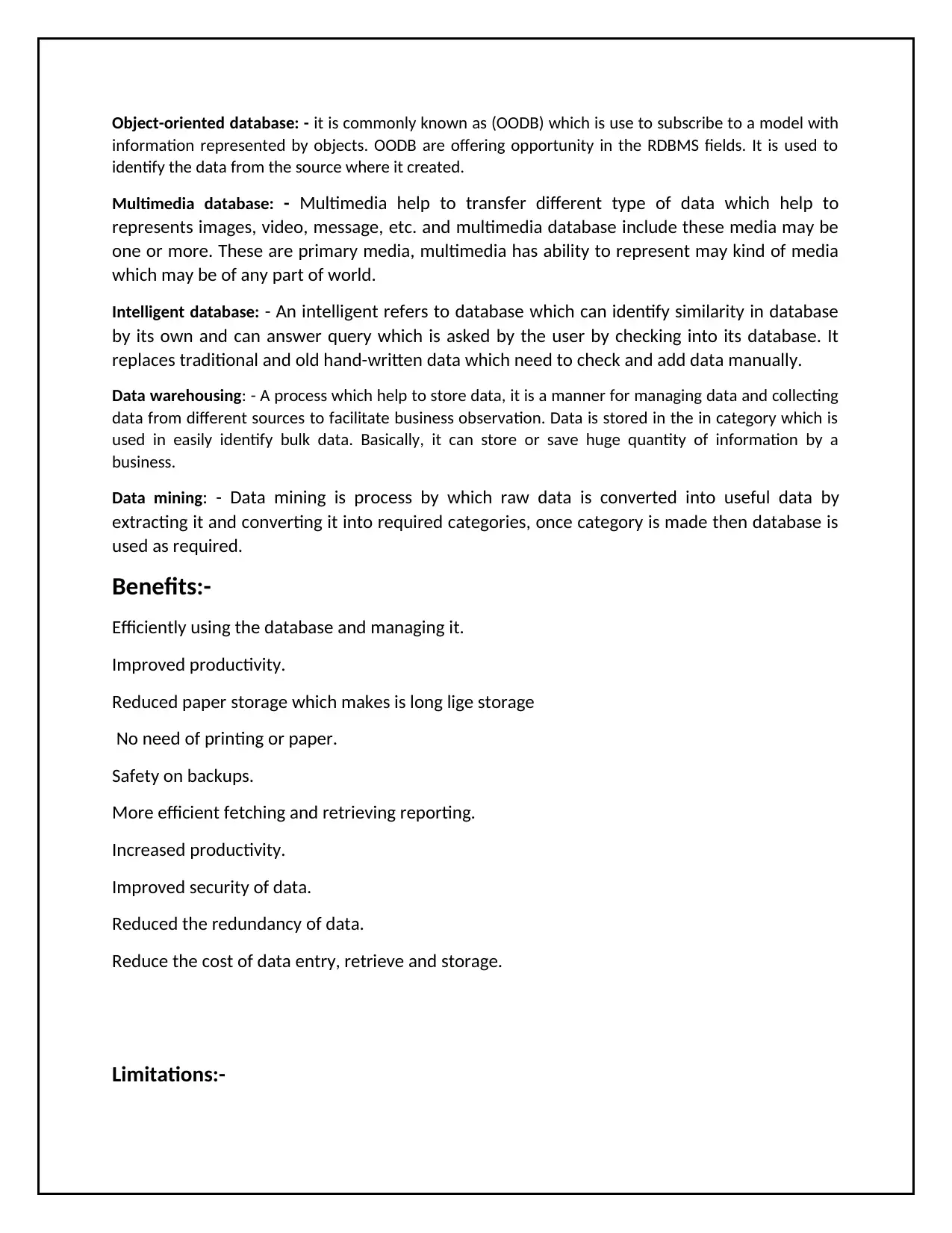
Object-oriented database: - it is commonly known as (OODB) which is use to subscribe to a model with
information represented by objects. OODB are offering opportunity in the RDBMS fields. It is used to
identify the data from the source where it created.
Multimedia database: - Multimedia help to transfer different type of data which help to
represents images, video, message, etc. and multimedia database include these media may be
one or more. These are primary media, multimedia has ability to represent may kind of media
which may be of any part of world.
Intelligent database: - An intelligent refers to database which can identify similarity in database
by its own and can answer query which is asked by the user by checking into its database. It
replaces traditional and old hand-written data which need to check and add data manually.
Data warehousing: - A process which help to store data, it is a manner for managing data and collecting
data from different sources to facilitate business observation. Data is stored in the in category which is
used in easily identify bulk data. Basically, it can store or save huge quantity of information by a
business.
Data mining: - Data mining is process by which raw data is converted into useful data by
extracting it and converting it into required categories, once category is made then database is
used as required.
Benefits:-
Efficiently using the database and managing it.
Improved productivity.
Reduced paper storage which makes is long lige storage
No need of printing or paper.
Safety on backups.
More efficient fetching and retrieving reporting.
Increased productivity.
Improved security of data.
Reduced the redundancy of data.
Reduce the cost of data entry, retrieve and storage.
Limitations:-
information represented by objects. OODB are offering opportunity in the RDBMS fields. It is used to
identify the data from the source where it created.
Multimedia database: - Multimedia help to transfer different type of data which help to
represents images, video, message, etc. and multimedia database include these media may be
one or more. These are primary media, multimedia has ability to represent may kind of media
which may be of any part of world.
Intelligent database: - An intelligent refers to database which can identify similarity in database
by its own and can answer query which is asked by the user by checking into its database. It
replaces traditional and old hand-written data which need to check and add data manually.
Data warehousing: - A process which help to store data, it is a manner for managing data and collecting
data from different sources to facilitate business observation. Data is stored in the in category which is
used in easily identify bulk data. Basically, it can store or save huge quantity of information by a
business.
Data mining: - Data mining is process by which raw data is converted into useful data by
extracting it and converting it into required categories, once category is made then database is
used as required.
Benefits:-
Efficiently using the database and managing it.
Improved productivity.
Reduced paper storage which makes is long lige storage
No need of printing or paper.
Safety on backups.
More efficient fetching and retrieving reporting.
Increased productivity.
Improved security of data.
Reduced the redundancy of data.
Reduce the cost of data entry, retrieve and storage.
Limitations:-
Paraphrase This Document
Need a fresh take? Get an instant paraphrase of this document with our AI Paraphraser
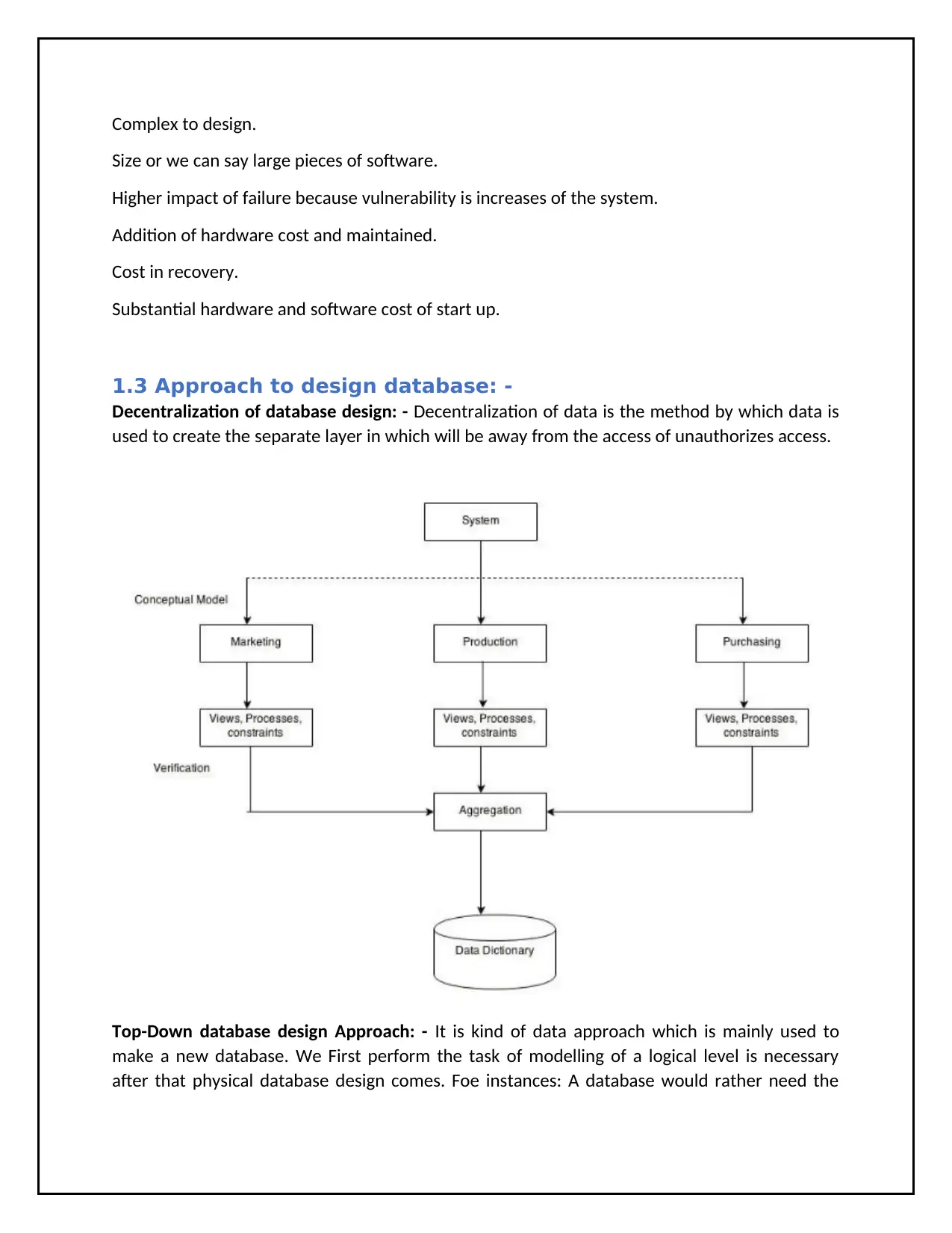
Complex to design.
Size or we can say large pieces of software.
Higher impact of failure because vulnerability is increases of the system.
Addition of hardware cost and maintained.
Cost in recovery.
Substantial hardware and software cost of start up.
1.3 Approach to design database: -
Decentralization of database design: - Decentralization of data is the method by which data is
used to create the separate layer in which will be away from the access of unauthorizes access.
Top-Down database design Approach: - It is kind of data approach which is mainly used to
make a new database. We First perform the task of modelling of a logical level is necessary
after that physical database design comes. Foe instances: A database would rather need the
Size or we can say large pieces of software.
Higher impact of failure because vulnerability is increases of the system.
Addition of hardware cost and maintained.
Cost in recovery.
Substantial hardware and software cost of start up.
1.3 Approach to design database: -
Decentralization of database design: - Decentralization of data is the method by which data is
used to create the separate layer in which will be away from the access of unauthorizes access.
Top-Down database design Approach: - It is kind of data approach which is mainly used to
make a new database. We First perform the task of modelling of a logical level is necessary
after that physical database design comes. Foe instances: A database would rather need the
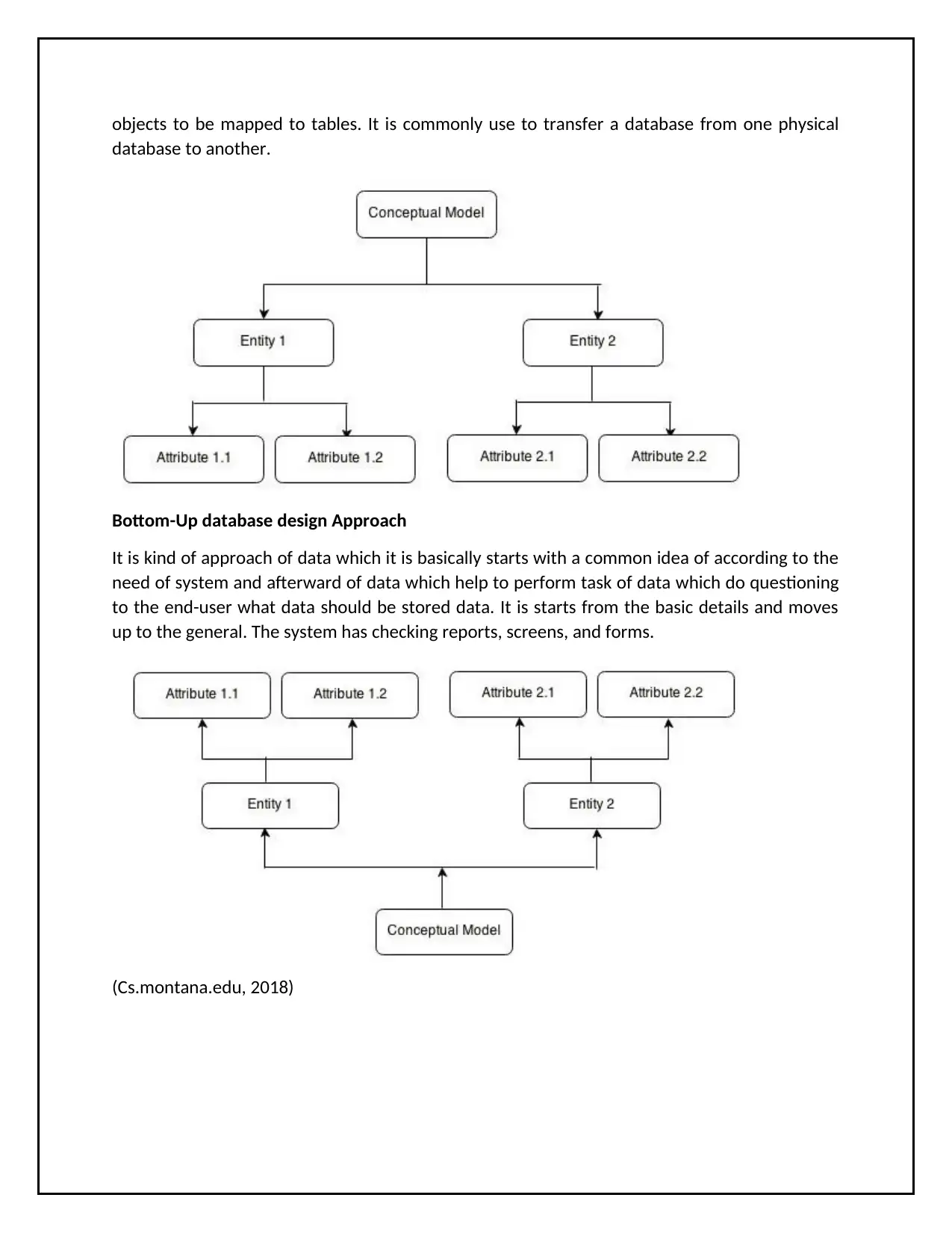
objects to be mapped to tables. It is commonly use to transfer a database from one physical
database to another.
Bottom-Up database design Approach
It is kind of approach of data which it is basically starts with a common idea of according to the
need of system and afterward of data which help to perform task of data which do questioning
to the end-user what data should be stored data. It is starts from the basic details and moves
up to the general. The system has checking reports, screens, and forms.
(Cs.montana.edu, 2018)
database to another.
Bottom-Up database design Approach
It is kind of approach of data which it is basically starts with a common idea of according to the
need of system and afterward of data which help to perform task of data which do questioning
to the end-user what data should be stored data. It is starts from the basic details and moves
up to the general. The system has checking reports, screens, and forms.
(Cs.montana.edu, 2018)
⊘ This is a preview!⊘
Do you want full access?
Subscribe today to unlock all pages.

Trusted by 1+ million students worldwide
1 out of 81
Related Documents
Your All-in-One AI-Powered Toolkit for Academic Success.
+13062052269
info@desklib.com
Available 24*7 on WhatsApp / Email
![[object Object]](/_next/static/media/star-bottom.7253800d.svg)
Unlock your academic potential
Copyright © 2020–2025 A2Z Services. All Rights Reserved. Developed and managed by ZUCOL.





